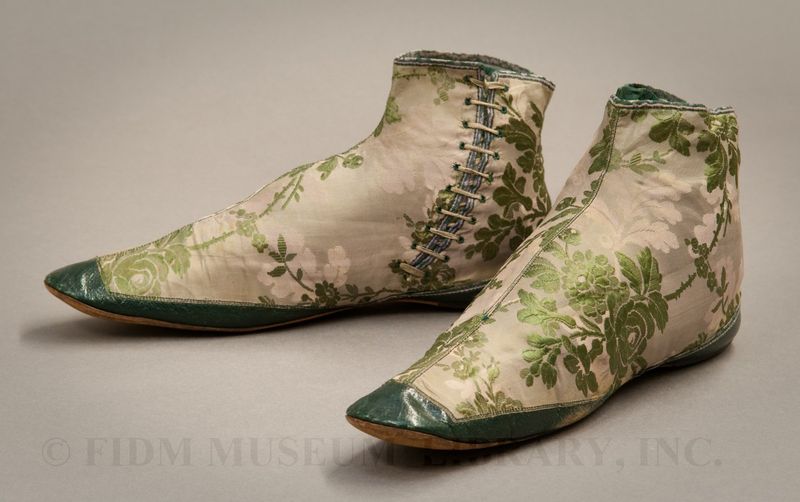Evening boots, 1850-55
Women of the mid-nineteenth century had essentially two choices when it came to fashionable footwear: ballet-like slippers or ankle boots. Both types of shoe were made of soft, pliable textiles such as velvet or satin and had a flat, extremely thin leather sole. No matter which shoes a woman wore, they were hidden by the full, floor-length skirts then in fashion. Because they were seldom seen, both types of shoe were usually made of a plain black or white textile. Evening boots were an exception, as they were sometimes made to match a specific gown. These pink and green evening boots from the FIDM Museum collection are made of a slightly iridescent brocade and damask silk with green leather foxing at the heel and toe. Due to the high-quality of both the construction and textile, we believe these boots were probably made in France and imported to the United States. The side lacing is typical of boots from this period.
 Evening boots 1850-55 Gift of Barbara Bundy 2006.37.3AB
Evening boots 1850-55 Gift of Barbara Bundy 2006.37.3AB
Though it's difficult to see in this image, these boots have what are called "straight soles." Straight soles lack left or right definition and are usually very narrow. Common from about 1600 and disappearing only in the late nineteenth century, straight soles eliminated the cost of producing a left and right last, lowering the overall cost of shoe manufacturing. Looking at the boot in the front of the image, you can see a light patch on the green leather foxing, near the sole. This wear is probably due to a difference between the natural shape of the wearer's foot and the straight soles. The foot was slightly wider than the shoe, causing the foxing to rub against the floor. When placed at the toe and heel, leather foxing resembled the look of men's footwear covered with gaiters. Because of this resemblance, woman's day and evening boots with foxing were often called "gaiter boots." Given the insubstantial materials used, these evening boots were clearly intended for indoor wear. At most, they would have been worn walking to and from a carriage. Though somewhat sturdier leather boots were available for the fashionable hobby of "pedestrianism," otherwise known as walking, most women wore insubstantial shoes on a daily basis. A movement to reform women's dress emerged in the 1850s, propelled largely by Amelia Bloomer's attempts to promote bifurcated garments for women. All garments perceived to oppress women through their fit or general impracticality were targeted for scorn, including shoes. Delicate shoes were specifically targeted in an 1853 article in the Philadelphia-based Home Magazine, which railed against "satin or paper thin soles when the condition of the streets requires a warmer, stouter, and more impervious covering for the feet." Though it's highly unlikely that delicate evening boots were worn for actual outdoor walking, harsh criticism of fashion over practicality was a cornerstone of the dress reform movement. The same article speculates as to "how many severe colds are brought on in this way, and how many fall victim to consumption from this same cause." 1
1 "A Seasonable Hint." Home Magazine December 1853: 477.